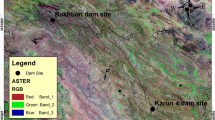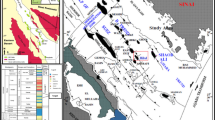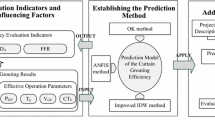Abstract
Nowadays, grouting plays a vital role in dam foundation. The purpose of the grouting with pressure is to fill the joints, discontinuities, void distance and cavities in the rock masses to consolidate and caulk the rock masses for reducing seepage and uplift pressure in the dam foundation and related structures. Cheraghvays dam is located at 17 km away from the west of the Saqqez in Kurdistan province of Iran. In the Cheraghvays dam, the grout holes were arranged at 2 m intervals and with 10.5 m final depth. There are three grout sections (0–2.5, 2.5–5.5, 5.5–10.5 m) inside each grout hole and the grout process was conducted from the bottom to the top. Finally, the controlling holes are used to perform Lugeon test and to check the grouting quality of the dam foundation. Checking the operations in all areas of the foundation causes cost and time consuming. In this paper, experimental variogram and their mathematical model are calculated by geostatistics methods. To assess consolidation grouting quality, secondary permeability was predicted by artificial neural network (ANN) and the linear regression method. For this aim, datasets of 68 blocks which include first permeability, cement take and secondary permeability have been collected. The obtained results have indicated that ANN can predict secondary permeability in Cheraghvays dam foundation better than the linear regression method. So, ANN can be used in consolidation grouting quality assessment.





Similar content being viewed by others
References
Abu-kiefa M (1998) General regression neural networks for driven piles in cohesionless soils. J Geotech Geoenviron Eng, ASCE 124(12):1177–1185
Ali M, Chwathe A (2000) Using artificial intelligence to predict permeability from petrographic data. Comput Geosci 26:915–925
Amini H et al (2011) Evaluation of flyrock phenomenon due to blasting operation by support vector machine. Neural Comput Appl. doi:10.1007/s00521-011-0631-5
Armstrong M (1950) Basic linear geostatistics. Springer, Berlin
Atici U (2011) Prediction of the strength of mineral admixture concrete using multivariable regression analysis and an artificial neural network. Expert system with applications 38:9609–9618
Baker W (1982) Grouting in geotechnical engineering. Geo-Institute of American Society of Civil Engineers, Reston
Basheer I (2000) Selection of methodology for modeling hysteresis behavior of soils using neural networks. J Comput-Aided Civ Infrastruct Eng 5(6):445–463
Basheer I, Hajmeer M (2000) Artificial neural networks: fundamentals, computing, design, and application. Microbiol Methods 43:3–31
Cambefort H (1967) Injection des sols: principles ET methods. Eyrolles editions, Paris
Canakci H, Baykasoglu A, Gullu H (2009) Prediction of compressive and tensile strength of Gaziantep basalts via neural networks and gene expression programming. Neural Comput Appl 18:1031–1041
Chan W, Chow Y, Liu L (1995) Neural network: an alternative to pile driving formulas. J Comput Geotech 17:135–156
Ewert F (1985) Rock grouting with emphasis on dam sites. Springer, Berlin
Foyo A, Sanchez M (2005) Permeability tests for rock masses, a proposal for a new expression for the equivalent Lugeon unit (ELU). Dam Eng 13(1–3):199–218
Goh A (1994) Seismic liquefaction potential assessed by neural networks. J Geotech Eng 120(9):1467–1480
Goh A (1995) Back-propagation neural networks for modeling complex systems. J Artif Intell Eng 9:143–151
Goh A (1995) Empirical design in geotechnics using neural networks. Geotechnique 45(4):709–714
Goh A (1995) Modeling soil correlations using neural networks. ASCE, J Comput Civ Eng, pp 275–278
Goh A (1996) Pile driving records reanalyzed using neural networks. J Geotech Eng, ASCE 122(6):492–495
Gothall R, Stille H (2009) Fracture dilation during grouting. Tunnel Undergr Space Technol 24(2):126–135
Hirota Y, Takebayasi S, Shibata I (1990) Prediction of grout take in dam foundation grouting—a case of Granite. J Jpn Soc Civ Eng 13(42):195–202
Houlsby A (1990) Construction and design of cement grouting—a guide to grouting in rock. Wiley, New York
Huang Y, Wanstedt S (1998) The introduction of neural network system and its application in rock engineering. Eng Geol 49:253–260
JSIDRE (1994) The fundamental knowledge on grouting japanese society of irrigation, drainage and reclamation engineering. Tokyo, Japan
Khandelwal M, Roy M, Singh P (2004) Application of artificial neural network in mining industry. Ind Min Eng J 43:19–23
Kriging D (1981) Lognormal-de Wijsian geostatistics for ore evaluation. In: S.A.I.M.M. Monograph Series 1, 2nd edn. South African Institute of mining and metallurgy, Johannesburg
Kulatilake P, Qiong W, Hudaverdi T (2010) Mean particle size prediction in rock blast fragmentation using neural networks. Eng Geol 48:298–311
Kutzner C (1985) Consideration on rock permeability and grouting criteria. In: 15th International Congress on Large Dams, Lausanne, Q.58, R.17
Lee I, Lee J (1996) Prediction of pile bearing capacity using artificial neural networks. Comput Geotech 18(3):189–200
Majidi A, Beiki M (2010) Evolving neural network using a genetic algorithm for predicting the deformation modulus of rock masses. Int J Rock Mech Min Sci 47:246–253
Mert E, Yilmaz S, Inal M (2011) An assessment of total RMR classification system using unified simulation model based on artificial neural networks. Neural Comput Appl 20:603–610
Monjezi M, Amini H, Yazdian Vajiani A (2011) Optimization of open pit blast parameters using genetic algorithm. Int J Rock Mech Min Sci 48:864–869
Monjezi M, Amini H, Yazdian Varjani A (2012) Prediction of flyrock and backbreak in open pit blasting operation: a neuro-genetic approach. Arab J Geosci. doi:10.1007/s12517-010-0185-3
Nawari NO, Liang R, Nusairat J (1999) Artificial intelligence techniques for the design and analysis of deep foundations. Elect J Geotech Eng (EJGE) 4. http://www.ejge.com
Neaupane K, Adhikari N (2006) Prediction of tunneling-induced ground movement with the multi-layer perceptron. Int J Tunnel Undergr Space Technol 21:151–159
Nikbakhtan B, Osanloo M (2009) Effect of grout pressure and grout flow on soil physical and mechanical properties in jet grouting operations. Int J Rock Mech Min Sci 46:498–505
Nonveiller E (1989) Grouting in theory and practice. Elsevier, Amsterdam
Olea R (1994) Fundamentals of semivariogram estimation, modeling, and usage. In: Yarus J, Chambers RL (eds) Stochastic modeling and geostatistics principles, methods and case studies. AAPG, Tulsa, pp 27–35
Pan G, Haris D (2000) Information synthesis for mineral exploration. Math Geol 8:851–856
Park H, West T, Woo I (2005) Probabilistic analysis of rock slope stability and random properties of discontinuity parameters, Interstate Highway 40, Western North Carolina, USA. Eng Geol 79:230–250
Ranjith P, Khandelwal M (2011) Artificial neural network for prediction of air flow in a single rock joint. Neural Comput Appl. doi:10.1007/s00521-011-0595-5
Schaap M, Leij F, Van Genuchten M (1998) Neural network analysis for hierarchical prediction of soil hydraulic properties. J Soil Sci Soc Am 62(4):847–855
Shibata I (1989) The determination of a rational injection pressure related to in situ stress in dam foundation grouting. J Jpn Soc Civ Eng 16(436):121–130
Singh V, Singh D, Singh T (2001) Prediction of strength properties of some schistose rocks from petrographic properties using artificial neural networks. Int J Rock Mech Min Sci 38(2):269–284
Teh C, Wong K, Goh A, Jaritngam S (1997) Prediction of pile capacity using neural networks. J Comput Civil Eng, ASCE 11(2):129–138
Tiryaki B (2008) Predicting intact rock strength for mechanical excavation using multivariate statistics, artificial neural networks and regression trees. Eng Geol 99:51–60
Weaver K (1991) Dam foundation grouting. Geo-Institute of American Society of Civil Engineers, Reston
Wyhthoff B (1993) Back propagation neural networks: a tutorial. Chemometr Intell Lab Syst J 18:115–155
Yamaguchi Y, Matsumoto N (1989) Permeability and Lugeon values of dam foundation. J Jpn Soc Civ Eng 12(412):51–60
Yang C (2004) Estimating cement take and grout efficiency on foundation improvement for Li-Yu-Tan dam. Eng Geol 75:1–14
Yilmaz I, Yuksek A (2008) An example of artificial neural network (ANN) application for indirect estimation of rock parameters. Rock Mech Rock Eng 41(5):781–795
Zadhesh J, Jalali S, Ramazanzadeh A (2013) Estimation of joint trace length probability distribution function in igneous, sedimentary and metamorphic rocks. Arab J Geosci. doi:10.1007/s12517-013-0861-1
Acknowledgments
The authors express their great appreciation to the Cheraghvays Dam field engineers; Amir Hafez-Quran and Ali Mushipanahi for technical support and collecting the necessary data.
Author information
Authors and Affiliations
Corresponding author
Rights and permissions
About this article
Cite this article
Zadhesh, J., Rastegar, F., Sharifi, F. et al. Consolidation Grouting Quality Assessment using Artificial Neural Network (ANN). Indian Geotech J 45, 136–144 (2015). https://doi.org/10.1007/s40098-014-0116-4
Received:
Accepted:
Published:
Issue Date:
DOI: https://doi.org/10.1007/s40098-014-0116-4




